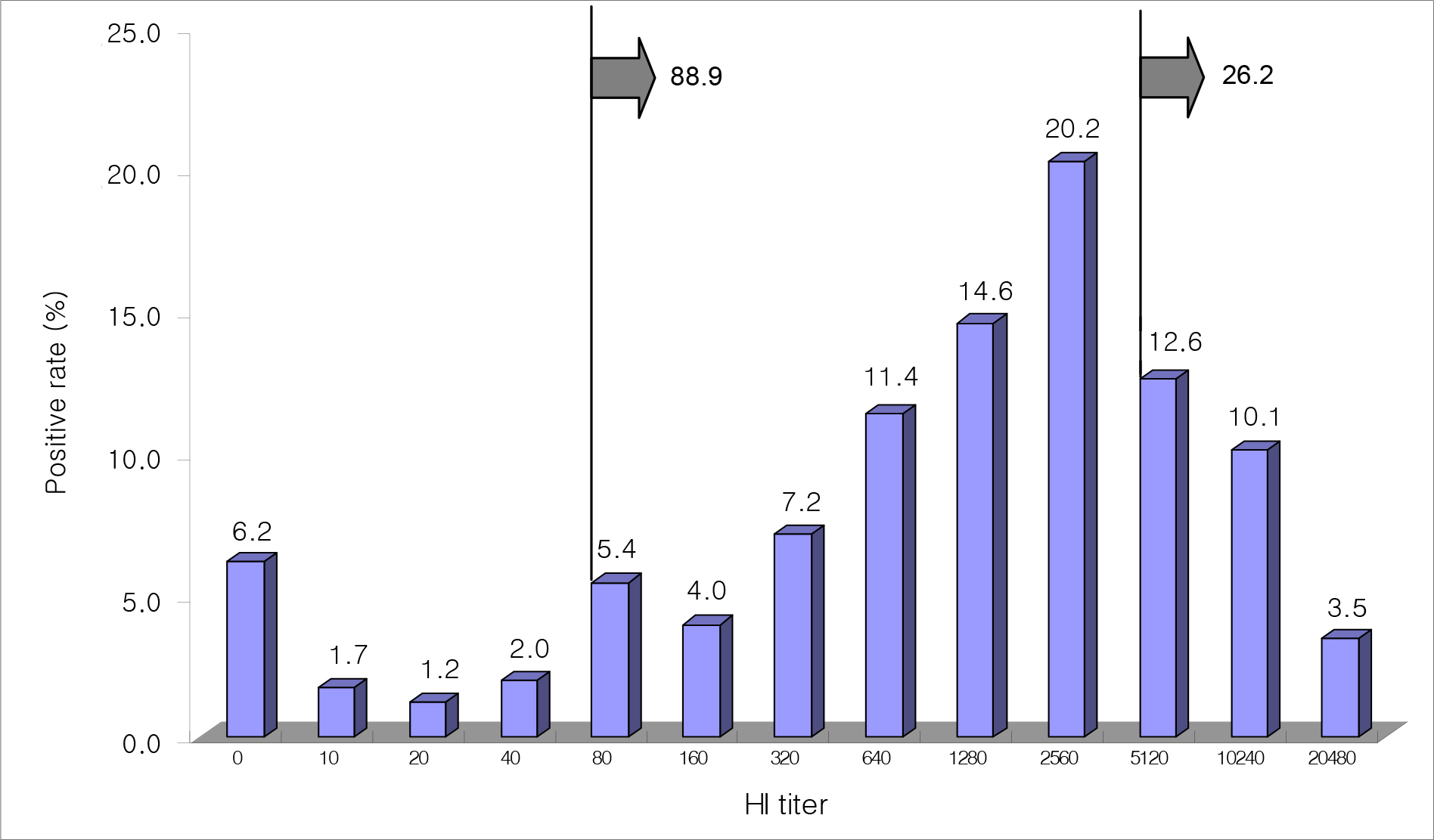J Bacteriol Virol.
2010 Jun;40(2):77-81. 10.4167/jbv.2010.40.2.77.
Serological Survey for Canine Parvovirus Type 2a (CPV-2a) in the Stray Dogs in South Korea
- Affiliations
-
- 1National Veterinary Research and Quarantine Service, MIFAFF, Anyang, Korea. yangdk@nvrqs.go.kr
- KMID: 1456270
- DOI: http://doi.org/10.4167/jbv.2010.40.2.77
Abstract
- Canine parvovirus type-2 (CPV-2) is one of the major diarrhea-causing agents, inducing acute hemorrhagic gastroenteritis in puppies. In this study, we conducted a seroepidemiological survey of CPV-2a in stray dogs in South Korea. In total, 405 canine sera, collected between 2006 and 2007, were screened for the presence of antibodies against CPV-2a using a hemagglutination inhibition (HI) assay. The positive rate in stray dogs tested for CPV-2a was 93.8%. The regional CPV-2a prevalence was 100% (8/8) in Jeju, 95.1% (232/244) in Gyeonggi, 94.7% (36/38) in Jeonra, 92.9% (13/14) in Gangwon, 92.7% (38/41) in Chungcheong, and 88.3% (53/60) in Gyeungsang province. No significant difference in the seropositive rate was found between male (93.6%) and female (94.0%) dogs. Analysis of the distribution of HI titer against CPV-2a according to the age of the stray dogs showed a linear increase in seroprevalence with age, although the association with age was not statistically significant. The incidence of stray dogs showing an HI antibody titer above 1:5120 was estimated to be 26.2%. Thus, the presence of high HI antibody against CPV-2a may indicate circulation of CPV-2a in stray dogs.
MeSH Terms
Figure
Cited by 1 articles
-
Serologic Survey of Rabies Virus, Canine Distemper Virus and Parvovirus in Wild Raccoon Dogs (
Nyctereutes procyonoides koreensis ) in Korea
Dong-Kun Yang, Ha-Hyun Kim, Jin-Ju Nah, Sung-Suk Choi, Jong-Taek Kim, Woong-Ho Jeong, Jae-Young Song
J Bacteriol Virol. 2013;43(3):204-209. doi: 10.4167/jbv.2013.43.3.204.
Reference
-
1). Appel MJ., Cooper BJ., Greisen H., Scott F., Carmichael LE. Canine viral enteritis. I. Status report on corona- and parvo-like viral enteritides. Cornell Vet. 1979. 69:123–33.2). Kang BK., Song DS., Lee CS., Jung KI., Park SJ., Kim EM, et al. Prevalence and genetic characterization of canine parvoviruses in Korea. Virus Genes. 2008. 36:127–33.
Article3). Truyen U., Agbandje M., Parrish CR. Characterization of the feline host range and a specific epitope of feline panleukopenia virus. Virology. 1994. 200:494–503.
Article4). Han HR., Hwang EK., Rhee YO., Yoo GY. Occurrence of acute viral enteritis in dogs in Korea. Korea J Vet Res. 1982. 22:167–70.5). Jeoung SY., Ahn SJ., Kim D. Genetic analysis of VP2 gene of canine parvovirus isolates in Korea. J Vet Med Sci. 2008. 70:719–22.
Article6). Moon HS., Lee SA., Lee SG., Choi R., Jeoung SY., Kim D, et al. Comparison of the pathogenicity in three different Korean canine parvovirus 2 (CPV-2) isolates. Vet Microbiol. 2008. 131:47–56.
Article7). Carmichael LE. An annotated historical account of canine parvovirus. J Vet Med B Infect Dis Vet Public Health. 2005. 52:303–11.
Article8). Oh JS., Ha GW., Cho YS., Kim MJ., An DJ., Hwang KK, et al. One-step immunochromatography assay kit for detecting antibodies to canine parvovirus. Clin Vaccine Immunol. 2006. 13:520–4.
Article9). Lamm CG., Rezabek GB. Parvovirus infection in domestic companion animals. Vet Clin North Am Small Anim Pract. 2008. 38:837–50.
Article10). Santos N., Almendra C., Tavares L. Serologic survey for canine distemper virus and canine parvovirus in free-ranging wild carnivores from Portugal. J Wildl Dis. 2009. 45:221–6.
Article11). Yang DK., Kim BH., Kim YH., Lee KW., Choi SS., Son SW. Genetic analysis of canine parvovirus vaccine strains in Korea. Korean J Vet Res. 2009. 49:243–8.12). Yang DK., Yoon SS., Kim BH., Byun JW., Lee KW., Kim YH, et al. Incidence of canine parainfluenza virus 2 in the Korean stray dogs by immunohistochemistry and serology. Kor J Vet Publ Hlth. 2009. 33:1–12.13). Dyce KM., Sack WO., Wensing CJG. Textbook of veterinary anatomy. 3rd ed.USA: Saunders;2002.14). Carmichael LE., Joubert JC., Pollock RV. Hemagglutination by canine parvovirus: serologic studies and diagnostic applications. Am J Vet Res. 1980. 41:784–91.15). Kim D. Typing and pathogenicity investigation of canine parvovirus isolates from Korea. Extramural research project report NVRQS. pp.p. 41–69. Anyang;Korea: 2007.16). Choi DY., Lyoo YS., Kwon HC., Kim YH., Kim DH. Incidence of canine parvo virus infection in Korea. Res Rept RDA. 1986. 28:108–14.17). Corrain R., Di Francesco A., Bolognini M., Ciucci P., Baldelli R., Guberti V. Serosurvey for CPV-2, distemper virus, ehrlichiosis and leishmaniosis in free-ranging dogs in Italy. Vet Rec. 2007. 160:91–2.
Article18). Korea animal health products association. Import and sales amount of animal health products. pp.285–312. Seoul, Korea,. 2008.19). Buonavoglia C., Compagnucci M., Orfei Z. Dog response to plaque variant of canine parvovirus. Zentralbl Veterinarmed B. 1983. 30:526–31.
Article20). Pollock RV., Carmichael LE. Dog response to inactivated canine parvovirus and feline panleukopenia virus vaccines. Cornell Vet. 1982. 72:16–35.21). Elia G., Cavalli A., Cirone F., Lorusso E., Camero M., Buonavoglia D, et al. Antibody levels and protection to canine parvovirus type 2. J Vet Med B Infect Dis Vet Public Health. 2005. 52:320–2.
Article
- Full Text Links
- Actions
-
Cited
- CITED
-
- Close
- Share
- Similar articles
-
- Isolation and identification of canine parvovirus type 2b in Korean dogs
- Evaluation of commercial immunochromatography test kits for diagnosing canine parvovirus
- Development of a novel vaccine against canine parvovirus infection with a clinical isolate of the type 2b strain
- Serologic Survey of Rabies Virus, Canine Distemper Virus and Parvovirus in Wild Raccoon Dogs (Nyctereutes procyonoides koreensis) in Korea
- New genotype classification and molecular characterization of canine and feline parvoviruses


